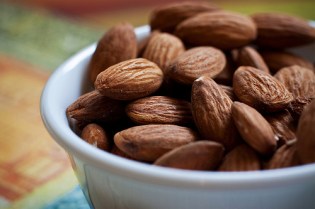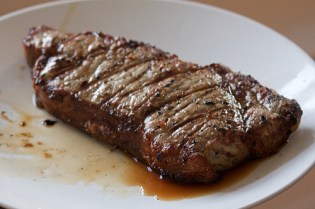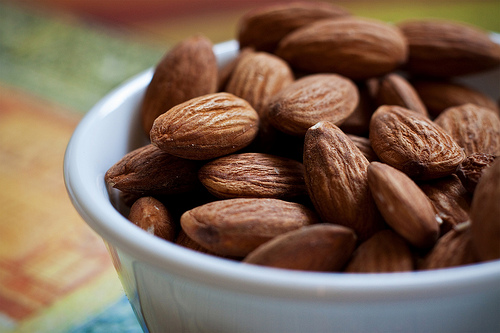This post is part of Protein Angst, a series on the environmental and nutritional complexities of high-protein foods. Our goal is to publish a range of perspectives on these very heated topics. Add your feedback and story suggestions here.

Photo by Nomadic Lass.
Protein: It’s the center of the American plate and the central component of many weight-loss diets. And if you spend much time looking at ads in gyms or men’s magazines, you might think it’s the most important nutrient ever discovered. Granted, protein is essential for body processes like cell growth and repair, so if you don’t get enough of it there can be serious health consequences. But how much protein do we really need?
Less than you might think (or than marketers of high-protein products would have you believe). The CDC reports that most Americans get more than enough protein, so the average person doesn’t need to worry about deficiencies. According to American Dietetic Association (ADA) recommendations, most active adults only need 0.8 grams of protein per kilogram of body weight per day. (A kilogram is 2.2 pounds.) So a person who weighs 125 pounds needs 45 to 57 g of protein in a day; for someone who weighs 175 pounds, it’s 65 to 80 g. Serious athletes need a bit more, but we’ll get to that in a minute.
Non-meat sources of protein can add up quickly: For example, you could have a single-serving Greek yogurt for breakfast (13 g protein); a vegetarian omelet with two eggs (14 g) and 2 ounces of soft tofu (2 g) for lunch; a handful of almonds as a snack (6 g); and a cup of brown rice (5 g) with half a cup of beans (7 g) for dinner. And that’s not even counting the small amounts of protein contained in fruits and vegetables — about 2 grams per serving for leafy greens, broccoli, and potatoes, and 1 gram per serving for many other vegetables and fruits.
Of course, meat packs a bigger protein punch than plant sources. A reasonably sized 3-ounce steak has about 21 grams of protein, while the 12-ounce behemoths served at many restaurants contain more protein than most adults need in an entire day, and a 16-ounce steak provides more than twice the daily protein needs of the average woman. Chicken, pork, and fish all contain roughly the same amount of protein per ounce as beef (although the amount of resource and energy required to produce each food is quite different — but more on that soon).

A 16-ounce steak provides two times the amount of protein the average woman needs in a day.
For vegetarians, and even more so for vegans, protein needs are slightly higher — up to 1 g per kg per day, according to Linda Chio, R.D., of NYU Langone Medical Center. This is because non-animal protein sources are less “complete” than animal sources, meaning they do not contain quite enough of all the essential amino acids. But combining different plant-based protein sources — like grains and legumes, such as the brown rice and beans mentioned above — can help correct for this difference in quality. Research indicates that complementary protein sources don’t even need to be eaten in the same meal, as long as they are consumed in the same day.
If you’re a serious athlete, that’s where it gets a little tricky. Athletes’ protein needs are widely debated, but the ADA has established guidelines that can at least help get you in the right ballpark. If you regularly do endurance training — like running medium-length races or going on long bike rides — you should aim for 1.2 to 1.7 g per kg. For a 150-pound person, that would be 82 to 116 grams per day. If you’re in heavy training — think preparing for a marathon or an Ironman competition — then you’ll want to get 1.4 to 2 g per kg. That works out to between 95 and 136 grams for our 150-pound athlete. If you’re into lifting weights and other strength training, you’ll need 1.6 to 1.7 g/kg. And if you’re an athlete who’s trying to lose weight, your protein needs will probably be at the higher end of the range for your chosen activity (although the latest research suggests that high-protein diets don’t help with weight loss). But many athletes may go overboard on the protein. A recent study by researchers at Saint Louis University found that a third of male collegiate athletes in the survey drastically overestimated their protein needs (and the other two thirds did not know how much they should be getting). Of course, the makers of protein supplements encourage this overconsumption: Some protein shakes or drinks contain 60 or 70 g of protein in one serving.
As Chio explains, consuming a large amount of protein at once, as in those shakes, just doesn’t make sense. “There is a point beyond which excess protein intake become less efficiently utilized,” she says, and then that extra protein gets excreted (or converted to fat, if you’ve eaten too many calories overall). Overconsumption of protein may also increase the risk of heart disease if the protein is from animal sources such as red meat, and too much protein can cause kidney damage in people whose kidneys are already mildly impaired. And that’s to say nothing of the natural resources (and money!) you’re probably wasting if the excess protein in your diet comes from energy-intensive sources.
So figure out how much protein you need, and try not to exceed it by too much. The planet, your wallet, and your waistline will thank you.



